As part of my effort to deal with the PTSD I suffered after visiting The House on the Rock, I thought I would write up my experience here.
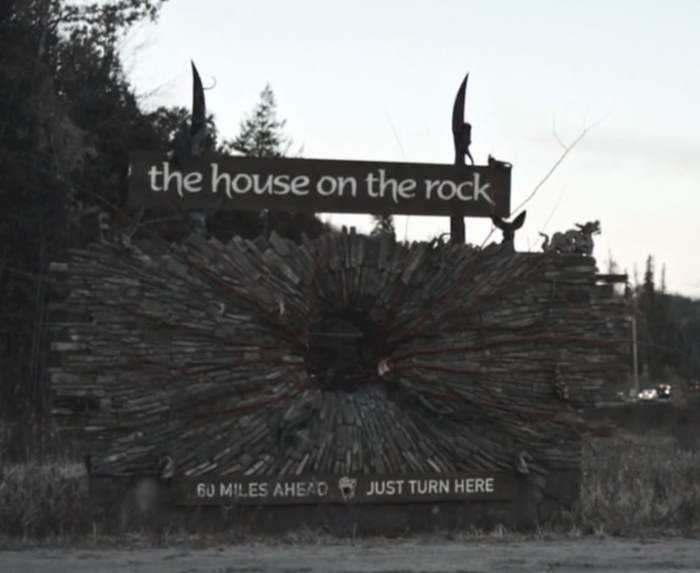
I first heard about The House on the Rock in Neil Gaiman’s masterpiece American Gods. Now that the book is being made into a television series, I wanted to visit before it becomes even more famous in the next season. The picture above is from the very end of Season 1.
I am in Minnesota for work, and I suggested to my friend Mike that I come up a day early and we drive out to The House on the Rock. It would be a long day as the attraction is four hours from Minneapolis, but I haven’t seen Mike in awhile and I was sure we could pass the time. The ride back was a lot quieter since we were still trying to process all that we saw. As sensitive as I assume Gaiman is, I can easily imagine that the whole idea of American Gods could have been triggered by visiting. It was both an amazing and an unsettling experience.
The House is located in a geographical area known as The Driftless, which is poetic on its own right. When glaciers extend and retract, they “leave behind silt, clay, sand, gravel, and boulders called drift”. This area was never exposed to glaciers, so it is both rugged and beautiful. It inspired Frank Lloyd Wright to build his studio and school Taliesin here, and the area is marked by tall columns of rock.
On one such column Alex Jordan Jr. decided to build a house. It started in 1945 as a private artist retreat, but word spread about the unusual house and by 1959 Jordan was able to charge admission. While the house itself is interesting in its own right, around the base were built a number of metal buildings which house the most eclectic and strange collection of items I’ve ever seen in one place.

We did not see that sign shown in the television show, but as it is supposedly sixty miles away we probably didn’t come that way. I did ask about it when buying tickets and the lady was pretty closed-mouthed about filming. It would be hard for me to imagine that they would try to build a copy of the House on a set, and the typeface used on that sign is used throughout the property, so I’m eager to see what sections make it on the show.
Around the entrance are a number of very tall pots decorated with lizards and other creatures and used as a planter for flowers. I have a better picture later on but you can see one to the left of the sign in the image above.
After a short drive you come to a parking lot and the main visitors center. Take note of the metal building to the left used to house some of the collection, and you can also see another one of those pots.
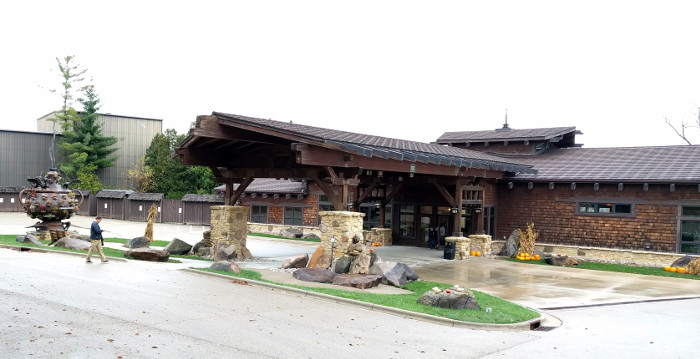
Here is where you buy your tickets and then you can enter another building that covers the history of the House. There are three sections you can tour, starting with the House itself. We decided to just do the first two, ending up at the Carousel. We are both glad we did because we were pretty weirded out by the end.
As a hint as to what to expect, the Visitor Center has a number of works that kind of set the mood for what you are going to see, such as this one.
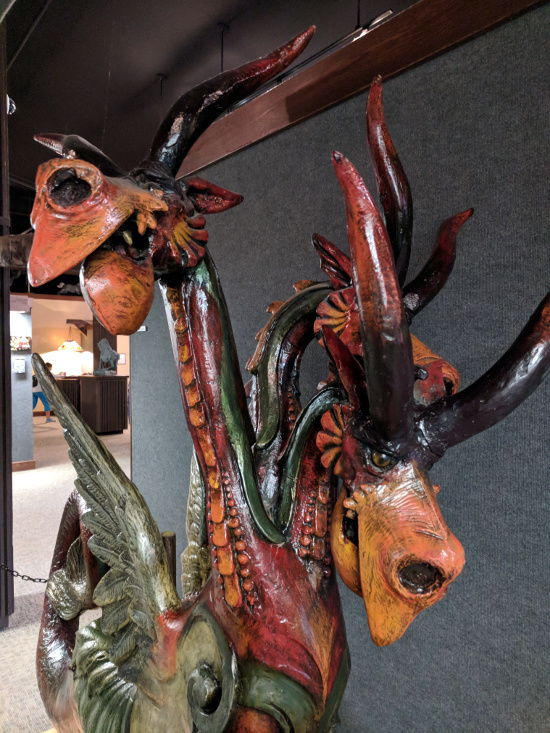
We wandered around the center for awhile but then were eager to start the tour. Even though it was lightly raining, all of the walkways are covered so it was easy to get around, and I also think that they limit what you can see to just what they want you to see. It was very hard to get a whole perspective of the place.
As you head to the House, you pass through the Asia Garden.
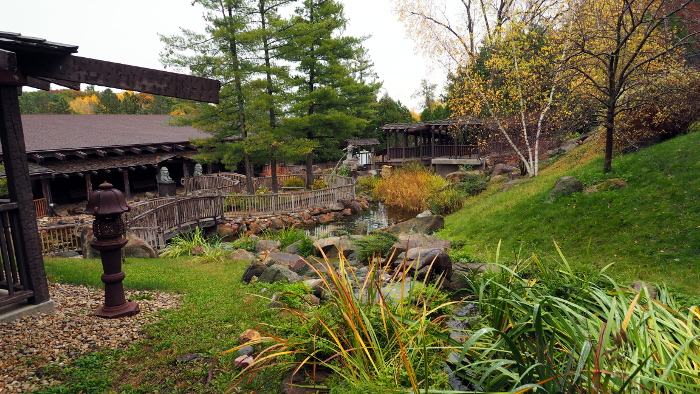
This was pretty and way too normal for what was going to come later. We wandered around for a bit before heading up the ramp to the House on the Rock.
Entering the House you have to stoop. The ceilings are quite low, which is surprising since Jordan was supposed to be six foot two. I asked one of the ticket takers and she said it was to keep in the heat, but I’m not totally convinced. The visitor center stated that Jordan tended to build without many plans, and would often tear down a section that didn’t work and rebuild it.
One of the first rooms you enter features a set of automated musical instruments. This group played Ravel’s Boléro.
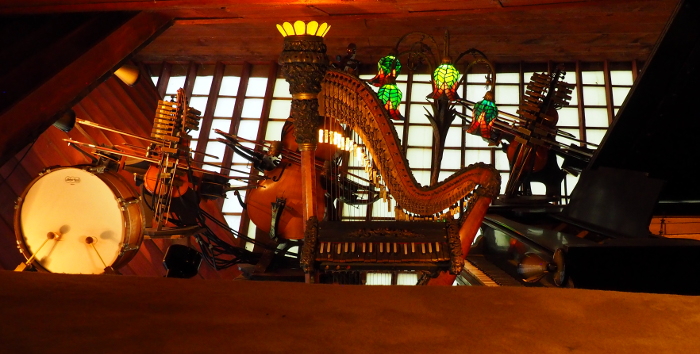
I haven’t been able to get that song fully out of my mind.
While it definitely looks like they are producing the music, I’ve read that some of the music coming from these animated machines is simulated. I can kind of believe that, since the amount of tuning and upkeep would be daunting. But then, considering how bad some of them sound, it is also easy to believe they are real. It is kind of at this point the place starts to seep into your mind. What is real, what isn’t, and what in the hell would drive someone to create stuff like this?
I also want to mention the smell. The House on the Rock smells very, very odd. Sometimes you get a whiff of something musty, like in an old attic. Other times it is a much more … biological smell. It is almost impossible to determine where the specific smells are coming from and they can wax strong and then wane faint in seconds. In telling people about our weekend, one person said they had a friend who had to leave because of the smell, but I just found it disconcerting.
Back in the 1950s to the 1970s, some “modern” houses were built with sunken areas called conversation pits. Many of the rooms in the House looked designed around that aesthetic.
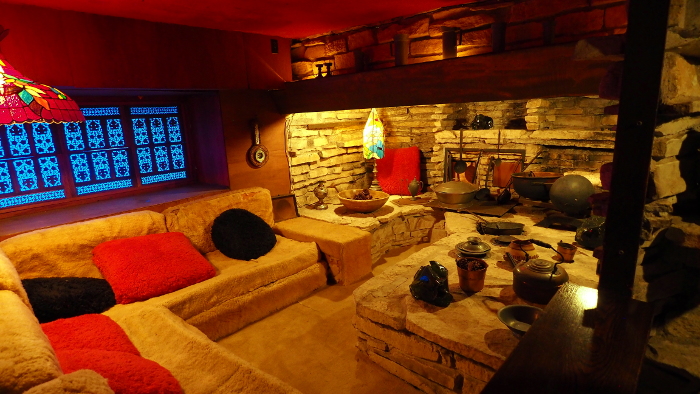
The House is built on many levels, and at one point we heard a player piano above us. Climbing some ramps and stairs we came to another decorated living space.

That’s Mike in the shorts and you can see the piano in the background. The entire tour was very dimly lit when not outside, so I will apologize in advance for the quality of some of the pictures.
At some point you end up at the Infinity Room. Built in 1985, this is a cantilevered 218 foot room that shrinks to a point in the distance, with around 3000 panes of glass forming the windows.
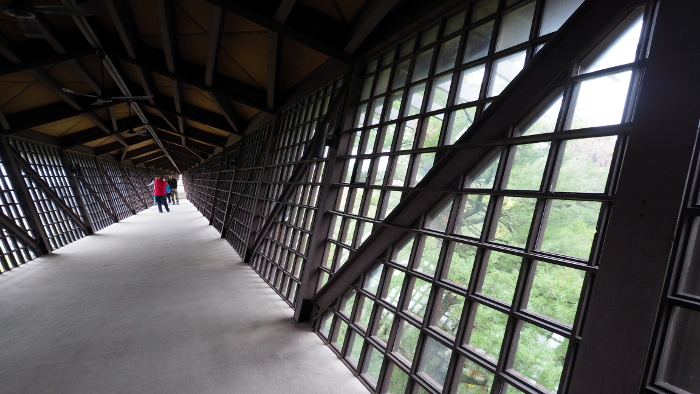
You can’t walk to the end of it, but when you get close there is a rectangle cut into the floor so you can look directly down on the tree tops.
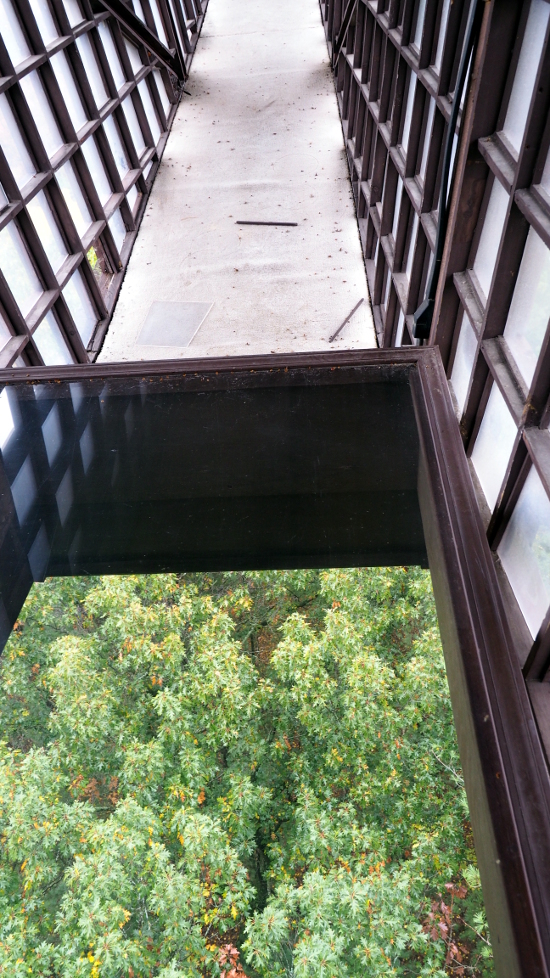
It kind of reminded me of the “Moon Door” in the Eyrie castle in the Game of Thrones television series.
You end up exiting the House the same way you came in, and I tried to get a shot of the exterior of the building. As I mentioned before, much of this is blocked by the covered walkway, but I was able to stick my camera out at arms length and get this picture.

After leaving the house you walk back down to start the second, and much weirder, part of the tour. We were there during the Halloween season, and so some of the place was decorated with things like skulls.

I want to point out the side of the metal building. They do an extremely good job keeping you from realizing that your a basically wandering around inside a big metal warehouse. We walked down the path and entered the building.
The first section we came to was called The Streets of Yesterday.
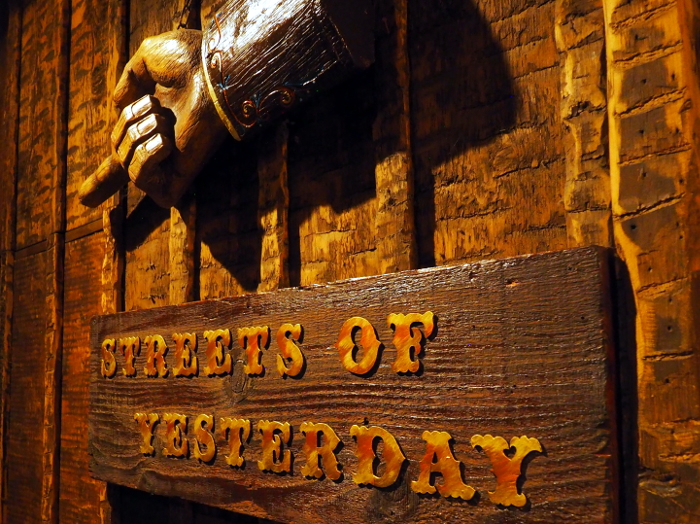
This is an area designed to look like a street in a small town in the 19th century. It reminded me a lot of Pirates of the Caribbean (the ride not the movie). You knew you were in a building but it was dark, the ceiling was high above you and the light was dim and indirect. The “street” was lined with a number of “shops” but I have never been in a place that would have shops like this so close together and it was more of a way to show off various collections.
Like dolls? Go to the doll store:

How about clocks?

and there was china:

Each store displayed a collection that would have been the pride of any collector of those particular objects, but it was weird seeing so many of them clumped close together. Plus there was little context. It’s like a rich compulsive hoarder met up with an OCD museum coordinator with an aversion to labels. It was also hard to tell what was real and what was just made up. Take this display of firearms:
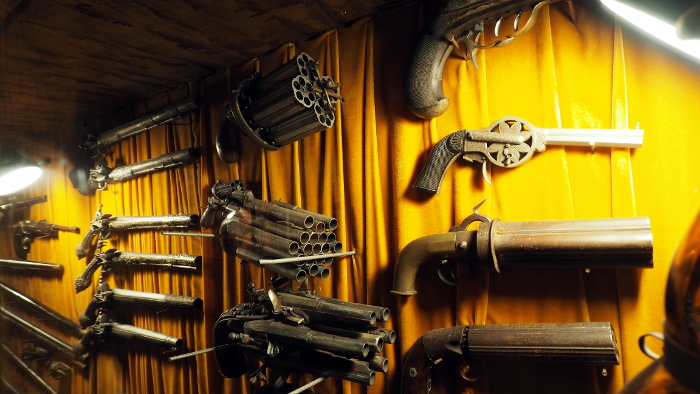
See those strange pistols with the many, many barrels? While some of them resemble real “pepper box” pistols, others looked like they were simply welded together to look funky and would never fire. But without context you didn’t know.
It was at this point my mind started going all sideways. Who would put something like this together? Who had a fetish for, say, dolls and antique brass cash registers?

We then moved on to a section dedicated to music machines called Music of Yesterday.
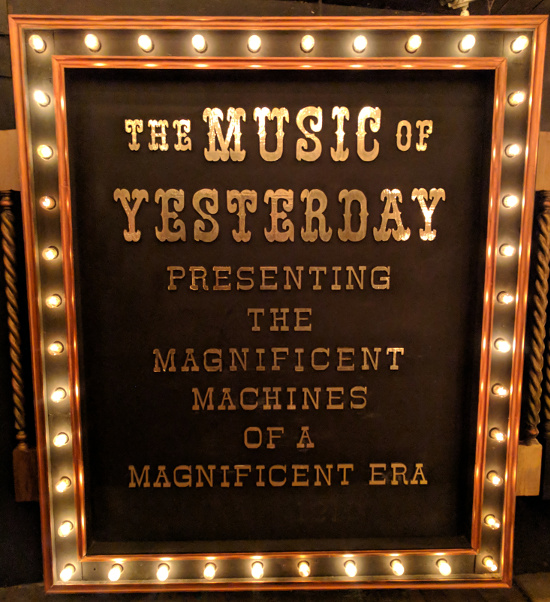
I should mention that a lot of these devices wouldn’t move or play until you inserted a token. I expected a token to be expensive, like one for a dollar, but it turns out they cost a quarter. This is wise on the part of the owners since if it were free people would just push everything they passed. I can’t imagine many of these devices would stand up to that kind of use. As it was, it was rare to pass one of the larger displays that someone had not already inserted a token.
We bought some tokens when we got to this player piano thing with an odd mechanism (it had a xylophone attached to it but it didn’t seem to use that part). The music was produced using a scroll of paper, like other player pianos, but instead of winding it on a spool it was just pushed and folded into a glass case at the top of the device.

It would feed out of the left side and then get smushed back in on the right. I was very surprised it worked.
While that was a standalone machine, many of the displays contained numerous musical devices.
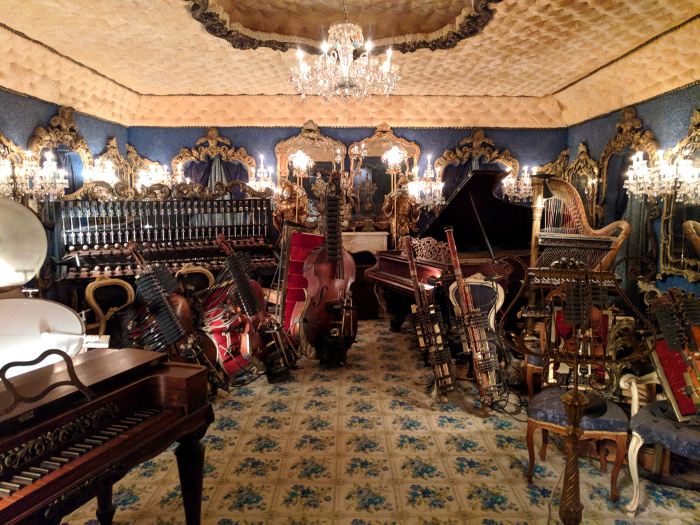
Probably the most famous is a machine called the “Mikado”. In the visitor center we read that Jordan had acquired a number of Asian figures in Chicago and they created this display to use them. I captured this one with a short video.
Melodious, no?
In the last room in this section there was a calliope called The Gladiator.
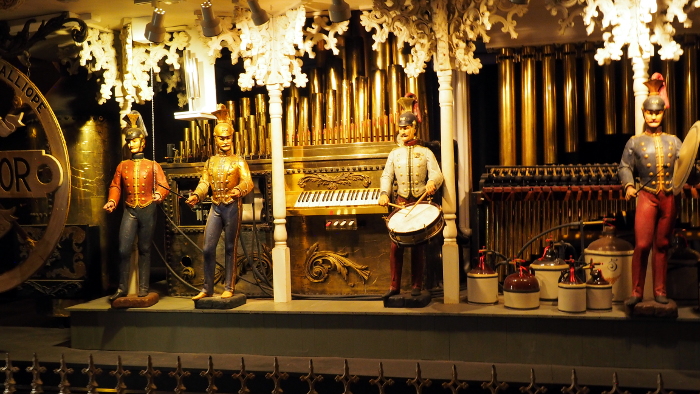
I liked this one because I thought the male figures looked like Sgt. Pepper’s Lonely Hearts Club Band.
Off to the right of The Gladiator was a small machine that told fortunes.

This device is mentioned in American Gods, and had I had the time to read up on it before visiting I would have inserted a token. As it was, I thought it was cool enough to take a picture of it.
As we left this section Mike and I were talking about a time we visited the main Google campus, but as we turned into the Heritage of the Sea display our conversation just trailed off into silence.
We were looking at this:

Now a blue whale can get up to one hundred feet long. This thing was two hundred feet long and huge. Who, I mean who makes something like this? It’s crazy. And if adding teeth to a two hundred foot long blue whale model wasn’t enough, why not have it being attacked by a huge Kraken/Octopus thing?
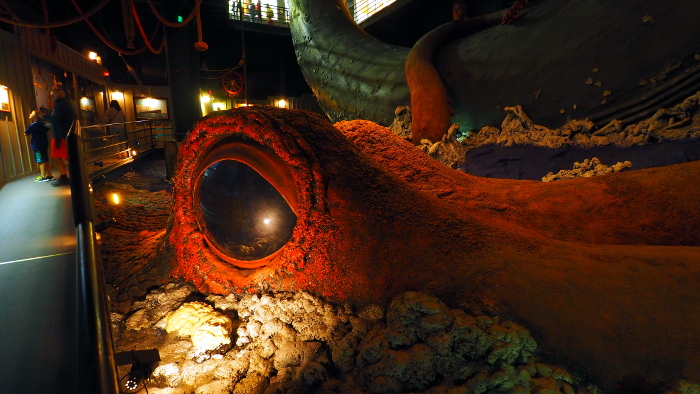
Again, here we are, in this huge room dwarfed by one of the largest sculptures I’ve ever seen and we were reduced to blubbering. Why? Seriously, why? We don’t even know what it was made of. It looked like it could have been formed concrete over a wire frame, but it was more likely some sort of foam that was sprayed and then carved (concrete would be very heavy)
It was crazy. Gaiman wrote of the House on the Rock in a blog post that “I had to tone down my description of it and leave things out in the book in order to make it believable.”
A set of ramps, five levels tall, surrounded this spectacle. In cases along the wall were collections of items with a nautical theme. There was a Titanic display with items that may, or may not, have been from the ship, such as a menu. In keeping with shipwrecks there was another case focused on the Lusitania. In between you might find scale models of tall ships or a Soviet sub. As you got higher you could see more of the massive sculpture in the center.

I did take a picture of two models of the Monitor and the Merrimack, considered the first battle between armored ships.

Another view of the Kraken:
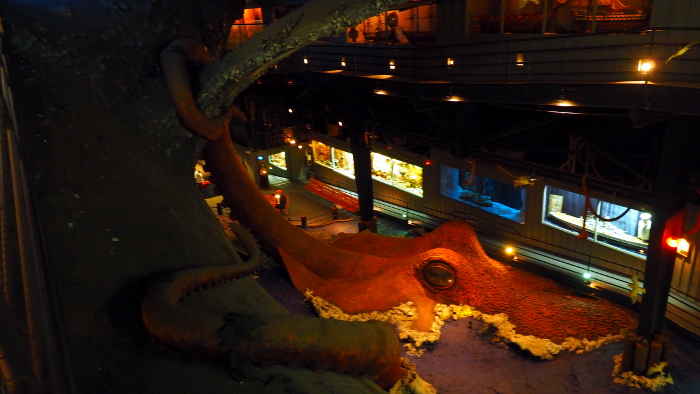
As I mentioned, this seems to be a blue whale, but blue whales do not have big teeth (like sperm whales do).
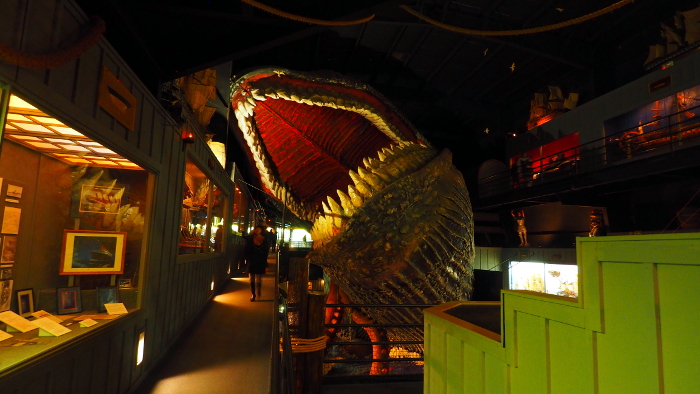
Of course, without the teeth it would have a hard time eating a boat, right?
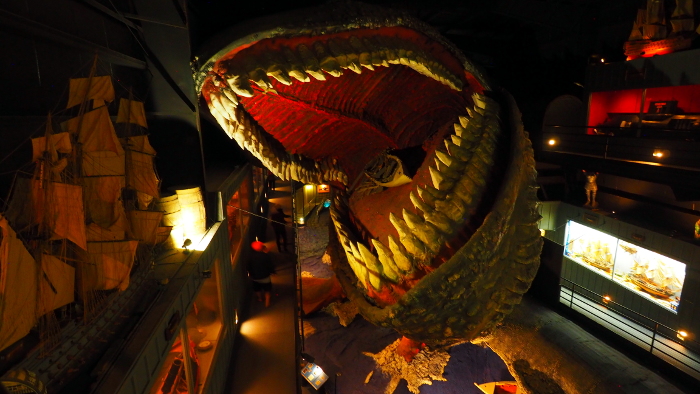
I can just hear the artist now: okay, we have this big honking whale thing being attacked by a big honking octopus thing, but something is missing. I know – a boat in the whale’s mouth.
After leaving Heritage of Sea we were a little shaken. It is hard to get across how this tour makes you feel. You are trying to puzzle out some sort of reason or system and it just isn’t there.
The next exhibits were tame by comparison. You get into an area that is a little more modern, so why not put up a bunch of hot air balloon models.
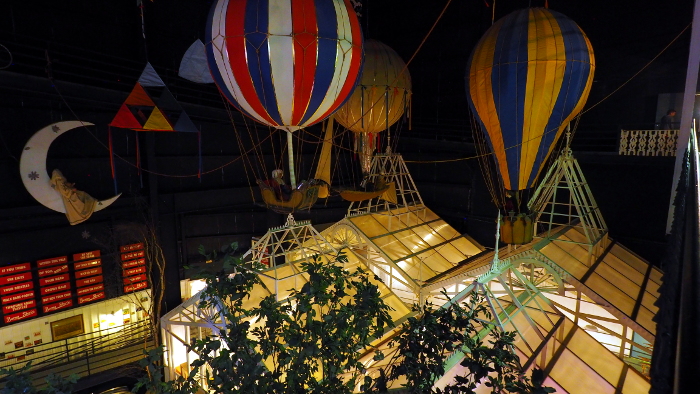
The tented space below was a pizzeria restaurant with some of the sorriest looking pizza I have ever seen. It also plays a role in American Gods and it isn’t like you can miss it since the way out is through the restaurant.
There were some other displays. For example, why not stick a perfectly normal looking Gull-wing Mercedes in this place?

If that is too normal, walk a few feet to admire a 1963 Lincoln Continental with suicide doors, a radiator modeled after the one on a Rolls Royce, and covered in over a ton of ceramic tile?
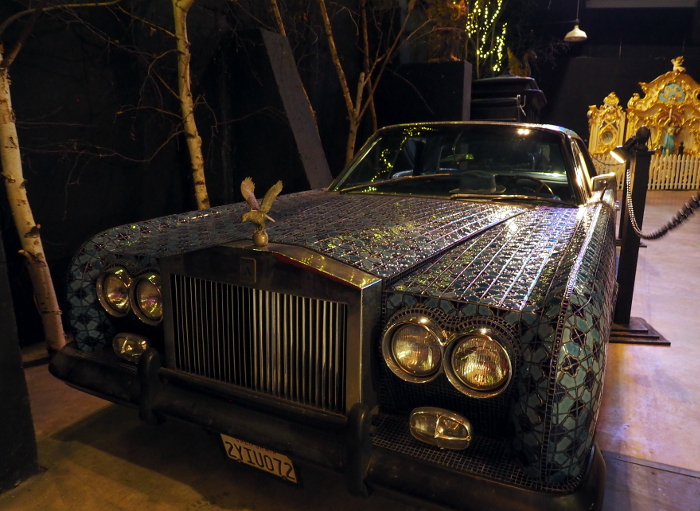
There was still a touch of the weird, such as a display featuring marionettes:
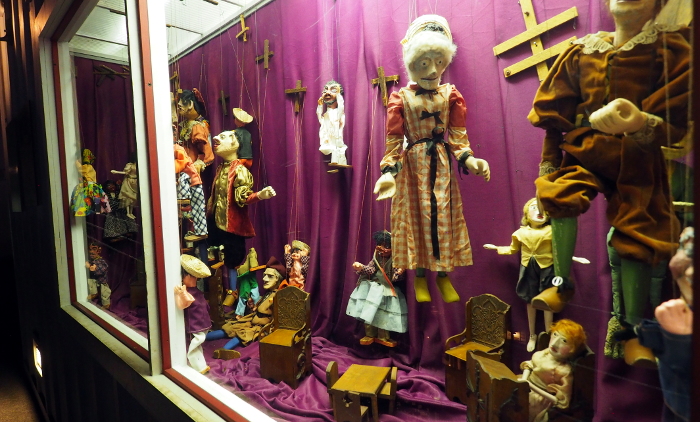
and a store that displayed cameras:

The camera display was labeled with detailed little cards for most of the items. Mike and I joked that the guy who set up the display must have been busily working along when Jordan ran in, saw the labels and screamed “What are you doing! Stop that right now!”
Exiting this area we came to a few more displays, including another elaborate music room.

For some reason the devices they used to control the strings reminded me of something out of H.R. Giger, and they reminded me of the facehuggers from Alien. I did put up a little video if you want to see them in action.
The final room on the tour was the coup de grace. It was a huge room dominated by the world’s largest indoor carousel. Eighty feet wide and 36 feet tall, it features over 20,000 lights, 183 chandeliers and 269 animals. Not one of which is a horse (I thought I saw one in the back but it turned out to have a fish tail, making it a hippocampus).
If that weren’t enough, the walls and ceiling were covered with angels. Well, female mannequins with wings. Just to try and explain the weirdness, many of the wigs weren’t on straight and some of the dresses were falling off. To finish the effect, throw in some of those automated musical instruments and add the mouth of a large monster (whose eyes move) leading the way to section three, just for good measure.
We’d had enough. After chatting with the employee in charge of watching over the carousel (you are not allowed to ride it), with followed the ominous sign out of the building.

You exit into the Japanese Garden, which was a beautiful example of normalcy after the previous two hours of insanity.
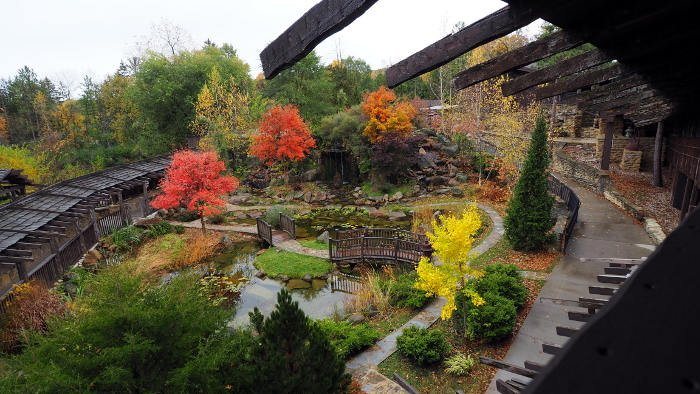
As you exit past the gift shop, there were a few more of those huge pots we saw at the entrance.
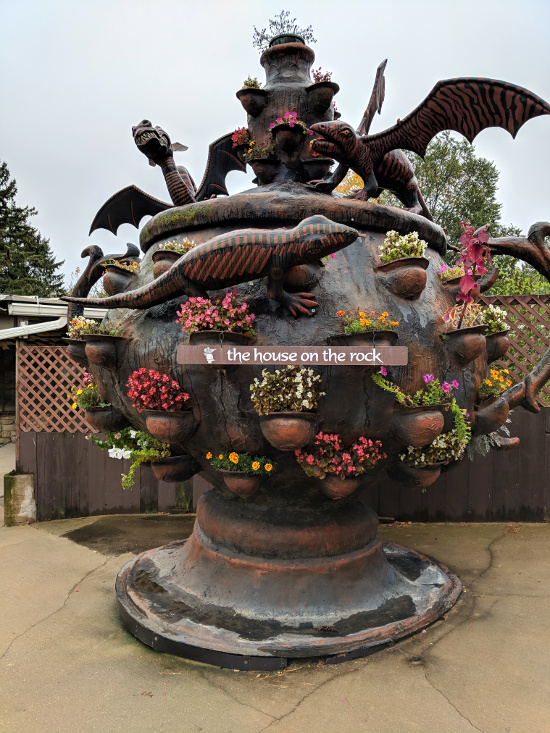
We made our way back to the car and started the long drive back to Minneapolis. We stopped at Taliesin but our hearts weren’t in it and we’d missed the last tour of the day in any case.
Two days (and one long blog post) later, I’m starting to come back to normal. I do want to go back and take Andrea. Perhaps I’ll have the nerve to do section three, and I would like to visit Taliesin. Even if you aren’t a fan of Neil Gaiman, if you have the chance to visit the House on the Rock, I urge you to take it.
It is a place of power.